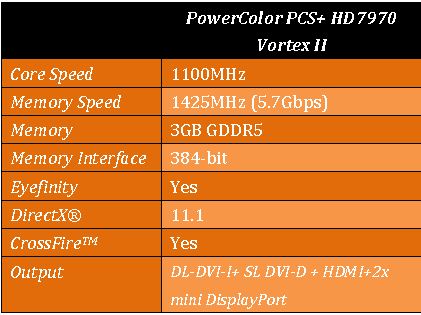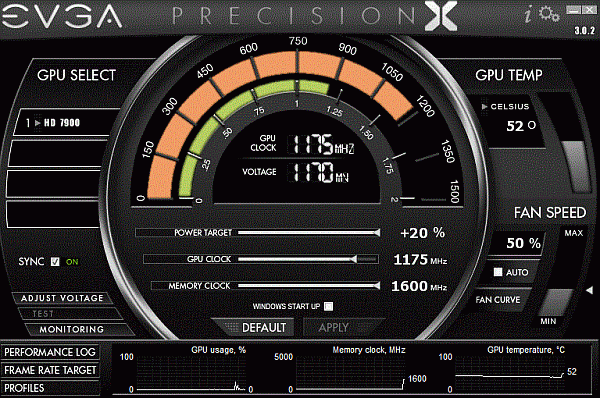Index


Review: GPU at 1100MHz with great cooling and low noise levels
PowerColor Vortex II cooler has become synonymous with PowerColor’s best graphics cards. You can find in on the company’s PCS+ series of factory overclocked graphics cards, which has recently been enriched with PCS+ HD 7970 Vortex II and PCS+ HD 7870 Vortex II cards. Our today’s guest is the faster card – PCS+ HD 7970 Vortex II.
In case you forgot, Radeon HD 7970 is AMD’s fastest single GPU graphics card. Its GPU is Tahiti XT, which packs 2048 stream processors. The reference version of HD 7970 cards comes with 3GB of GDDR5 memory, which is enough even for hard core gamers so PowerColor ran with that. However, the company still overclocked the memory from reference 1375MHz to 1425MHz.
HD 7970 Vortex II’s GPU runs at 1100MHz. This impressive overclock of almost 19 percent (175MHz) means that the best Tahiti XT GPUs can run beyond 1GHz and score some really great performance. Of course, Vortex II cooling plays an important role as it provides adequate cooling for the GPU, memory and other components that bear the burden of the overclock.
In fact, Vortex II cooling promises 12 percent lower temperatures while at the same time being up to 15 percent quieter than the reference cooler. This is what PowerColor says on the box, but we will check that out soon.
We believe you’re anxious to find out about the design of HD 7970 Vortex II graphics card and how it fares versus Nvidia’s GT 680, so we’ve got a treat for you. Namely, we have two GTX 680 graphics cards, one of which is a factory overclocked Phantom graphics card, so the fight should be interesting.
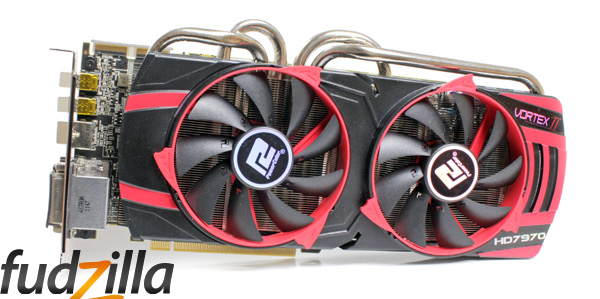
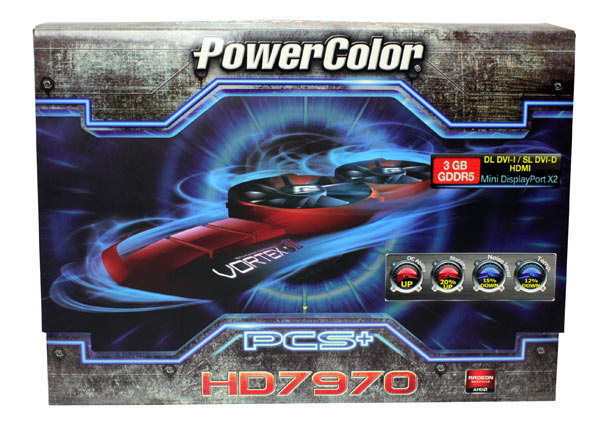
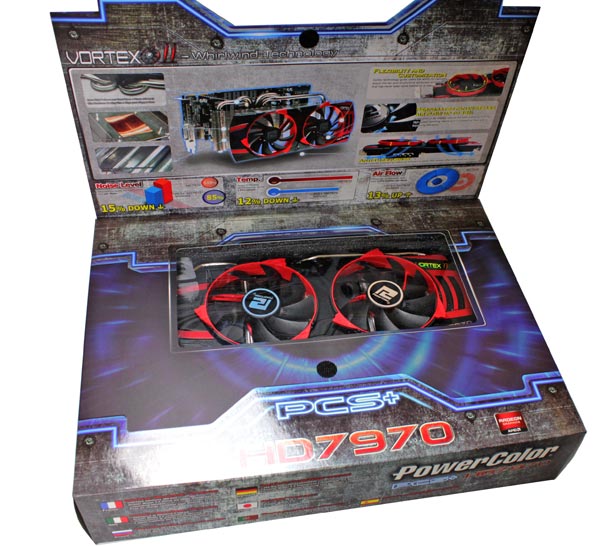
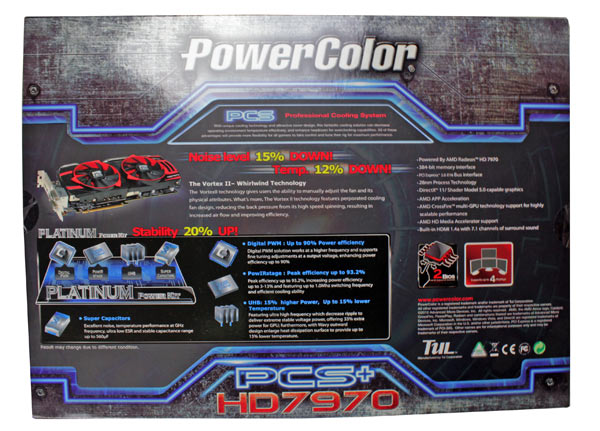
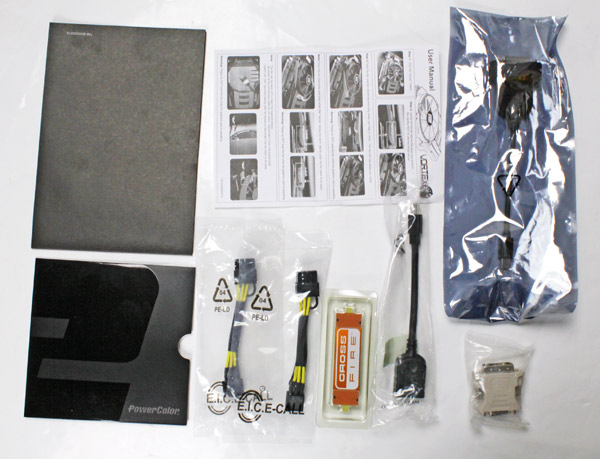
Vortex II comes with four heatpipes. Coolers usually come with thinner, 6mm heatpipes but PowerColor opted on thicker 8mm pipes that provide superior performance. Vortex II has two fans.
In its normal state, Vortex II takes up two slots. The fans, which normally lean on the heatsink, can be lifted in order to get better airflow and thus better cooling. In Vortex mode, the card takes up three slots. The card is 27.5 cm long, just like HD 6970.
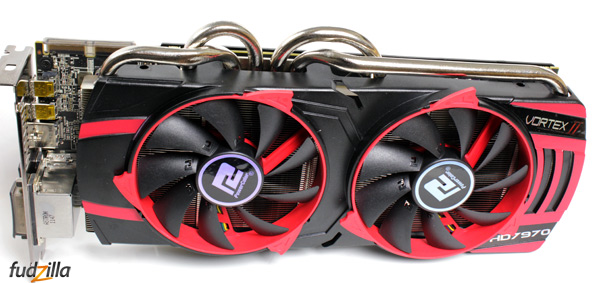
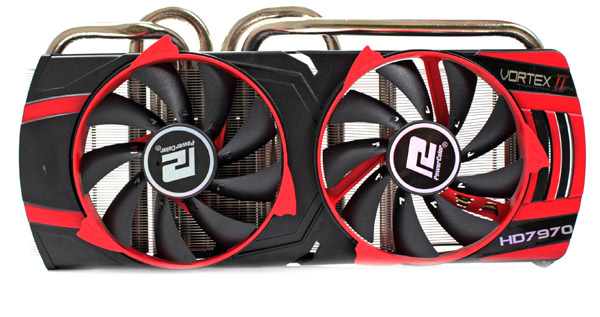
The copper heatpipes differ in length, which also makes sure that heat is evenly distributed throughout the entire block.

You’ll need to adjust the fans separately but couple of handles and a light push will do the trick. The fans on PSC+ HD 7970 Vortex II can be moved even when the card is running, but make sure that it’s screwed tight to the back panel.

You can even incline the fans slightly so that airflow is aimed at either end of the card. We actually didn’t see any benefits of doing so but it is said that it helps in reducing of turbulence and ensuring effective spreading of heat from hot areas. In this mode, fans absorb cooler air from the bottom of a case, balancing ambient temperatures.


Also, you can twist and push up fans after they’re rotated to remove them, in case you want to clean the heatsink.
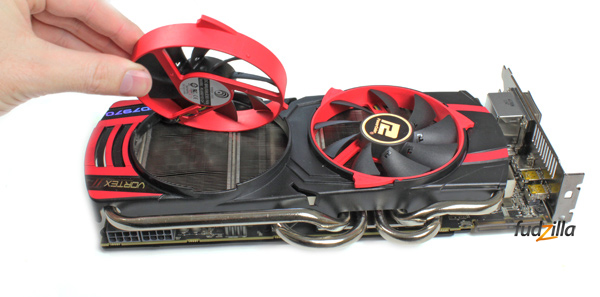
Match the “dot” (pictured below) with its recess to reconnect the fan back to its base.
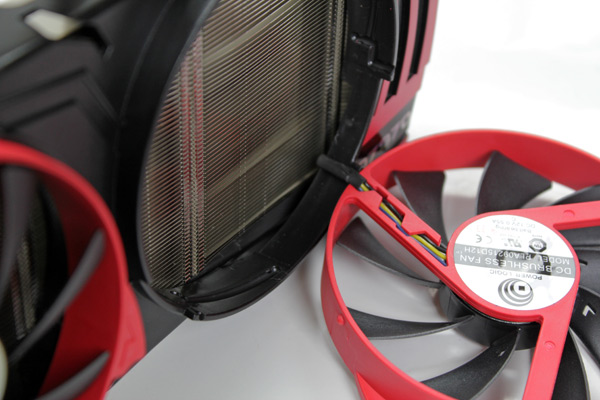
According to tests done by PowerColor, perforation in the fan blades should reduce the back pressure from its high speed spinning, resulting in increased air flow and improved efficiency.
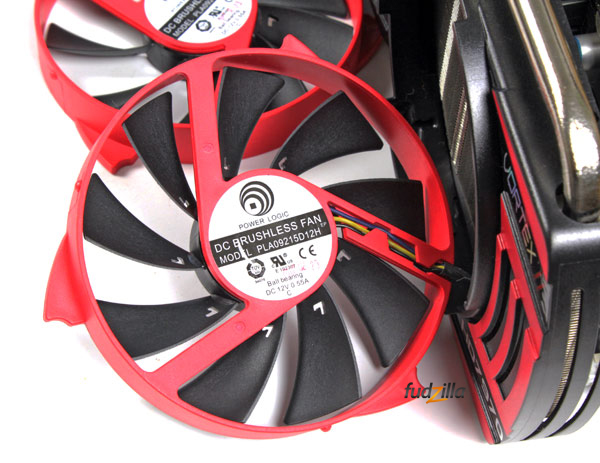
Vortex II’s cooler is equipped with two fans but they share the same 4-pin power connector. However, this is not as important because the driver will take care of setting the same RPM for both fans. Fan speed regulation can be performed via Catalyst Overdrive or any other tool you may prefer.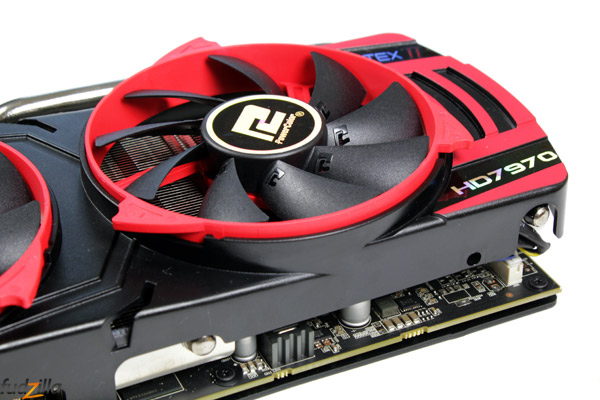
The memory chips are exposed and do not have a passive cooling solution on top of them.
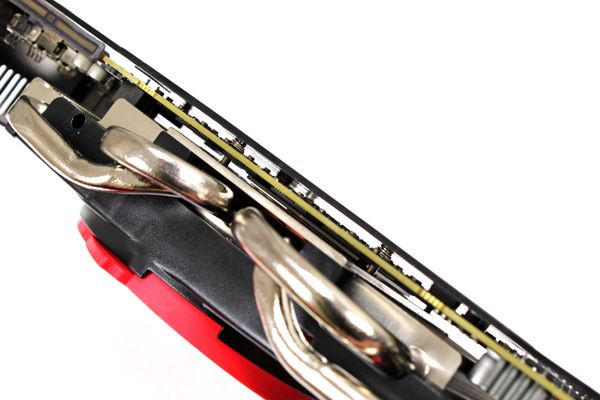
Backplate doesn’t actually touch the card and is a few mm away, but should prevent hot air pockets from forming around the PCB’s hotspots.
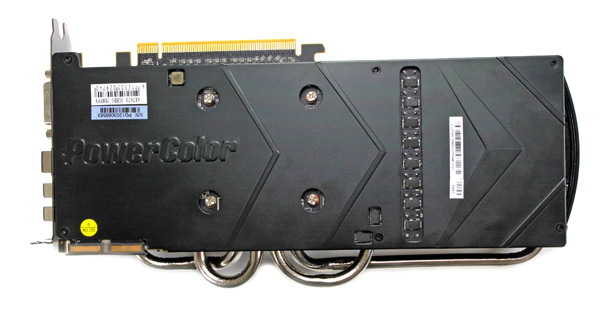
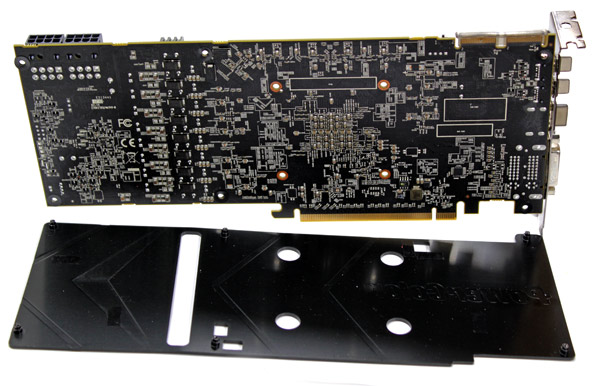
PCS+ HD7970 Vortex II card is equipped with 3072MB GDDR5 memory. The GDDR5 memory chips are made by Hynix (model number H5GQ2H24MFR-R0C).
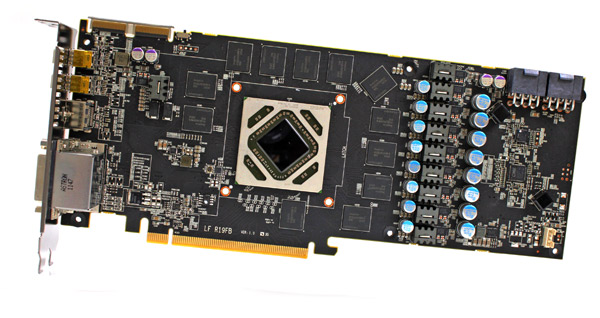
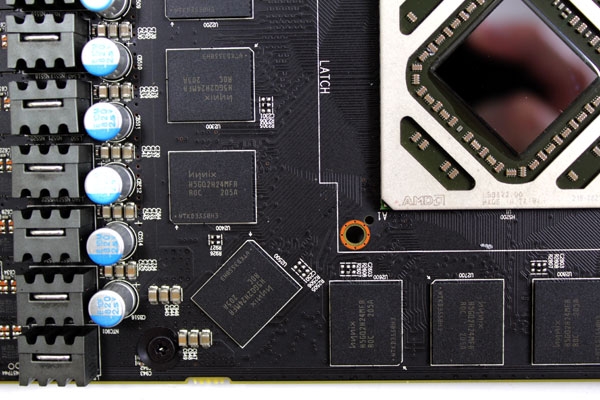
Software GPU voltage control is possible due to use of CHiL's 8228G voltage regulator which supports voltage monitoring via the I2C communications protocol and comes with extensive monitoring and tweaking features.
Vortex II cooler’s base, as well as nickel-plated heatpipes are made of copper.
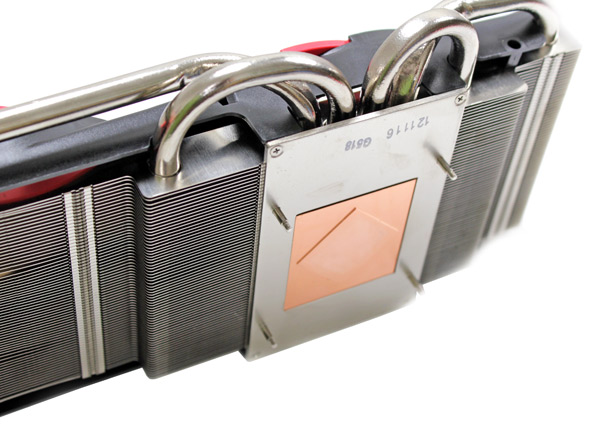
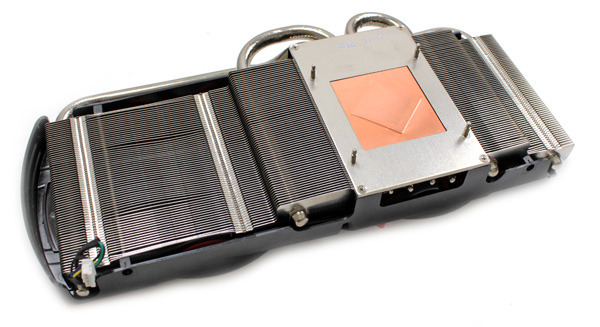
The I/O panel features two mini-DisplayPort 1.2 connectors, one standard HDMI 1.4a and two dual-link DVI connectors. The video outs come with protective plastic covers.
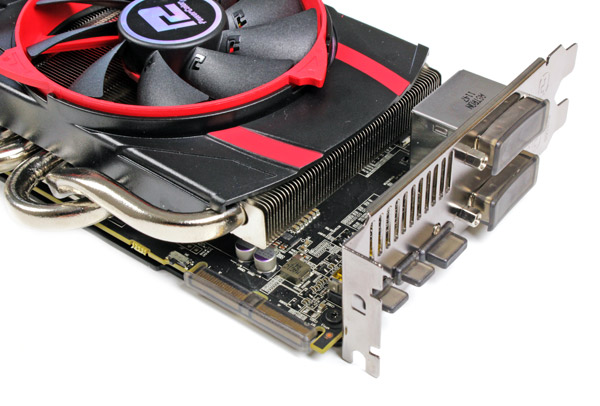
By using DisplayPort outputs it’s possible to chain up to six monitors to a single card. You can run four monitors directly from this card by using two mini-DisplayPort connectors, the HDMI connector, and one of the DVI connectors. As far as sound goes, HDMI 1.4a provides Dolby True HD, DTS-HD, AC-3, DTS and up to 7.1 channel audio with 192KHz/24bit output.
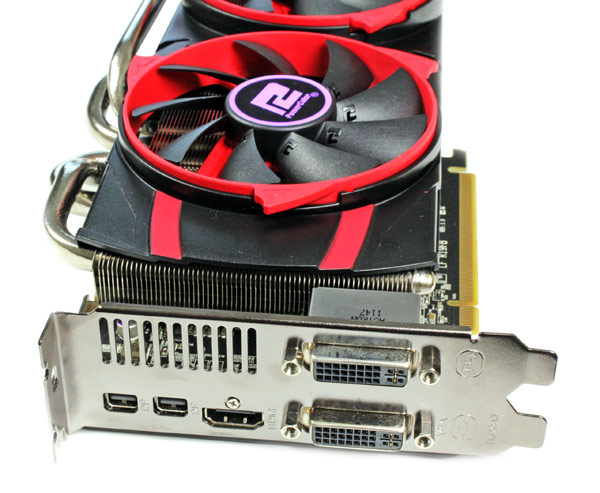
PCS+ HD 7970 Vortex II is powered via two 8-pin connectors, unlike the reference design which uses one 6-pin and one 8-pin connector.
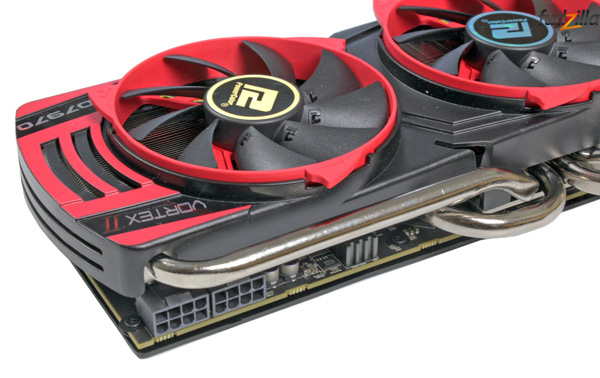
HD 7970 comes with two CrossFire connectors. This means that you can use four cards in 4-way CrossFire.
Motherboard: EVGA X79 FTW
CPU: Sandy Bridge-E Core i7 3820 (3.6GHz)
CPU Cooler: Thermalright HR-02 (Thermalright-Europa Distri www.PC-Cooling.de).
Memory: 8GB ADATA DDR3 1600 XPG Gaming series
Harddisk: OCZ Vertex 2 100 GB
Power Supply: CoolerMaster Silent Pro 1000W
Case: CoolerMaster Cosmos II Ultra Tower
Operating System: Win7 64-bit
Nvidia 301.10-desktop-win7-winvista-64bit-english-whql
amd_radeon_hd_7800_8.95.5_win7-64
12-3_vista_win7_64_dd_ccc.exe
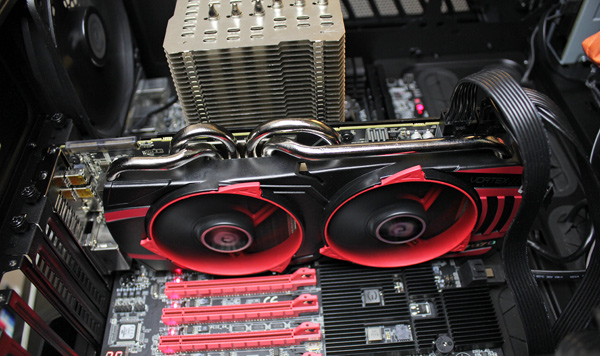
3DMark 2011
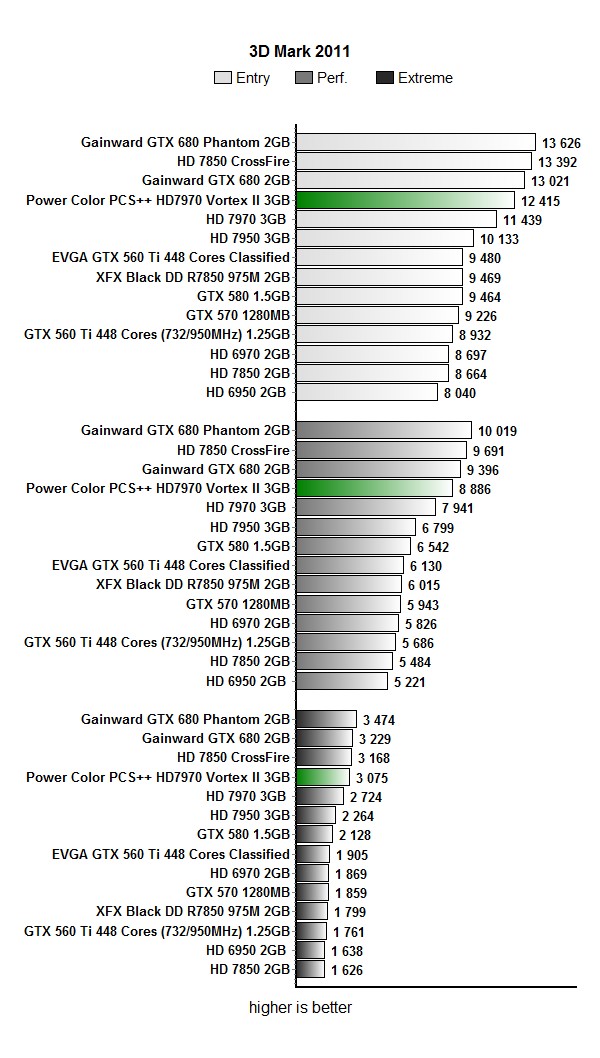
Crysis 2
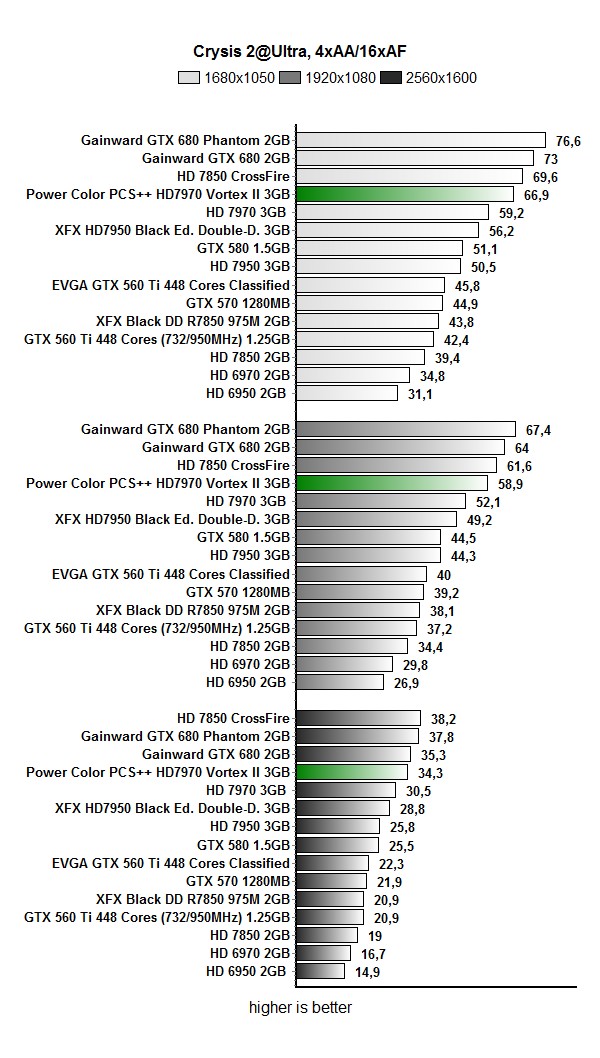
Aliens vs Predator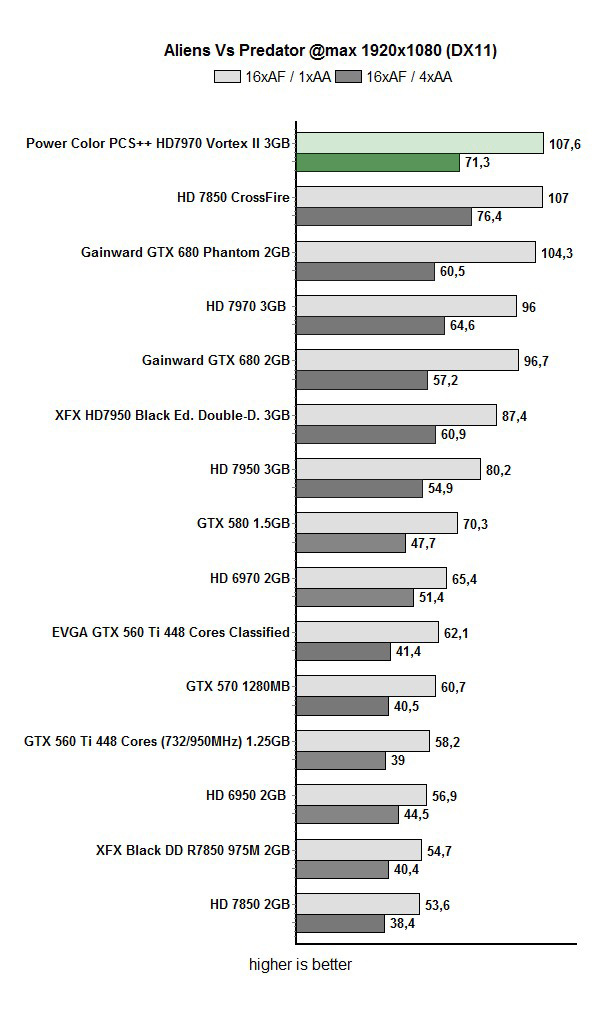
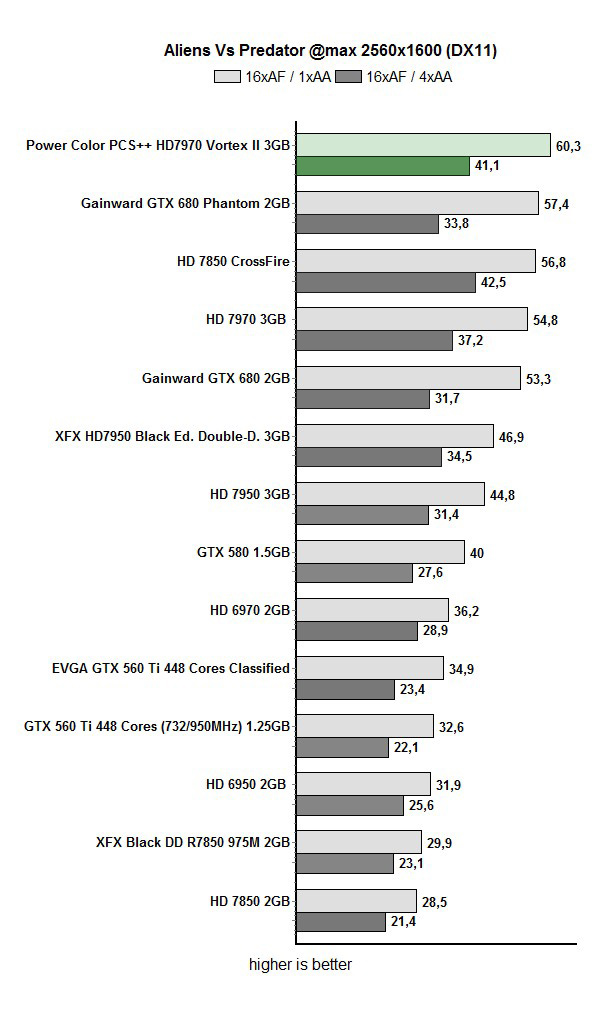
Metro 2033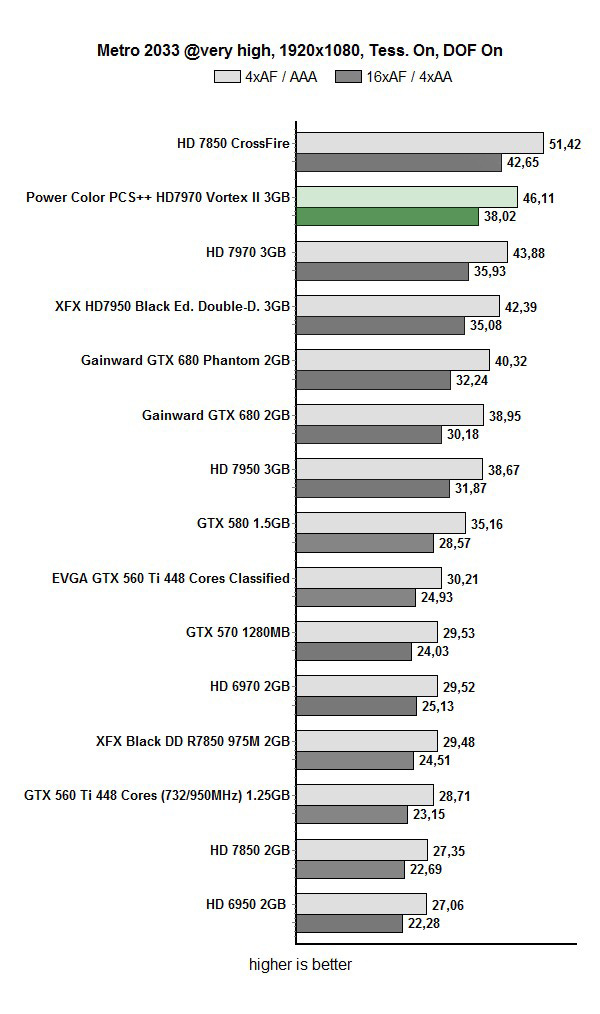
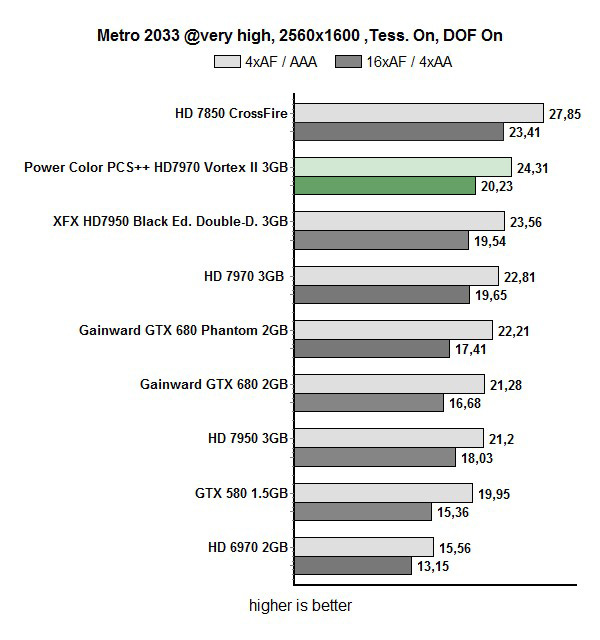
Unigine Heaven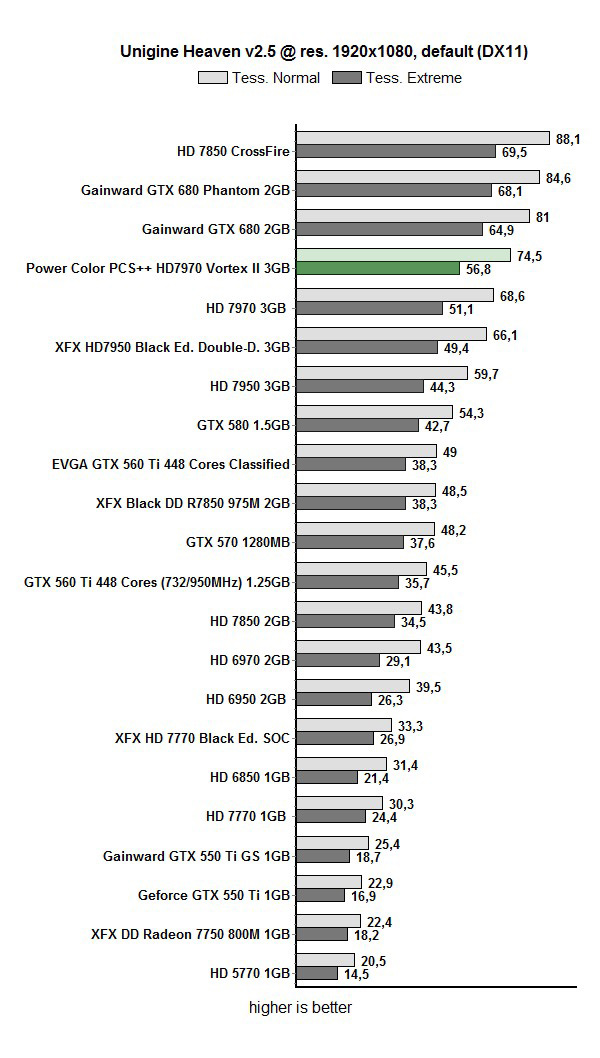
If we were holding a reference version of HD 7970 where GPU runs at 925MHz and memory at 1375MHz, we’d be quite content overclocking the GPU by 175MHz (almost 19 percent). However, we’re talking about PowerColor’s PCS+ HD7970 Vortex II graphics card that already boasts a 175MHz overclock.
Many HD 7970 graphics cards may falter before reaching 1100MHz, but PowerColor made a careful selection ensuring that only the crème of the crop GPUs end up in their cards running at 1100MHz+. The “+” is here because we managed to overclock the card even further.
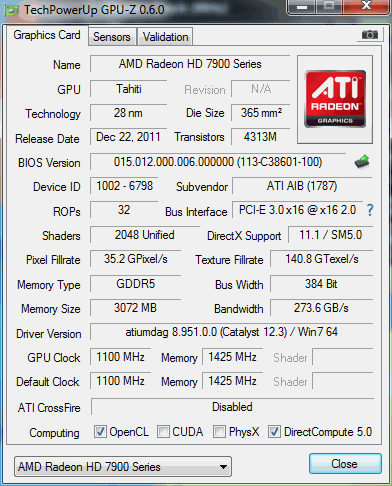
PCS+ HD 7970 Vortex II graphics card comes with dual BIOS and we’ve seen that both include the factory overclock. You can use the second BIOS during overclocking and revert to the first BIOS in any case of trouble.
We managed to push the GPU to 1175MHz and we couldn’t do better regardless of upping voltages or speeding up the fans. So, we managed to hit 1175MHz GPU and 1600MHz for the memory with default fan and voltage settings defined in VGA BIOS. We must say that this is an excellent result. Thermals were good even after our overclocking and the fans were pretty quiet, but more on that on the next page.
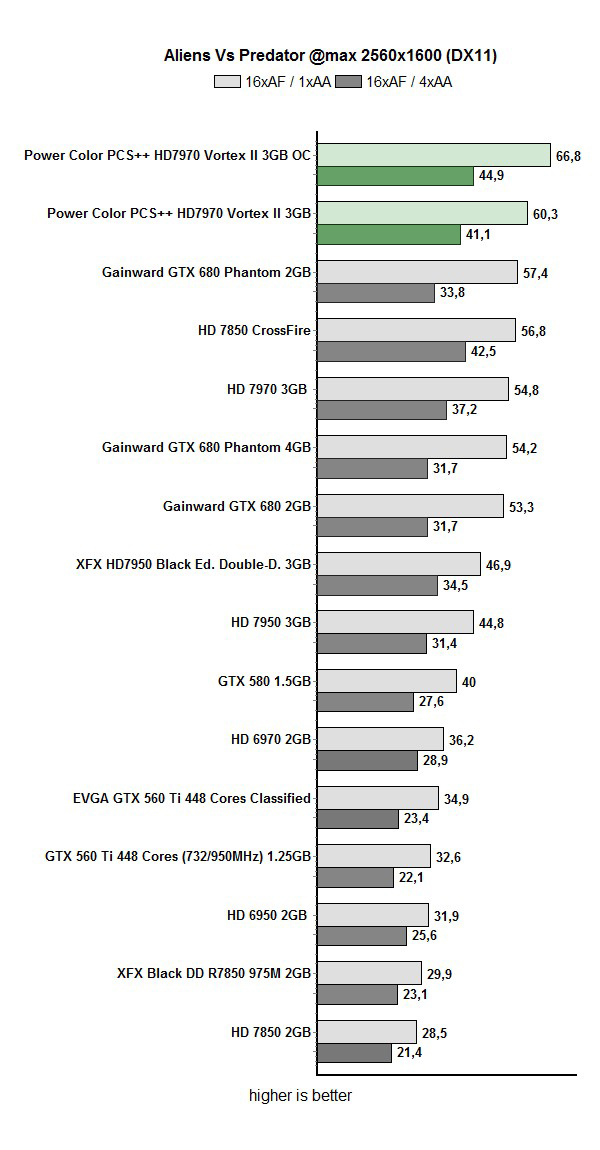
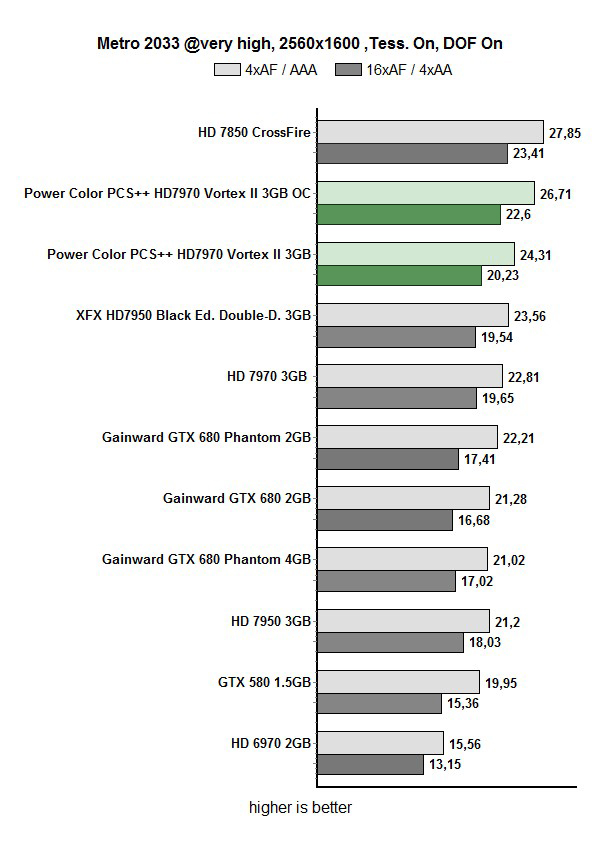
PowerColor uses Vortex II cooling on its PCS+ HD 7970 card and it has no trouble cooling the factory overclocked Tahiti XT chip.

Before we move on, we must note that we changed the thermal paste because two screws were quite loose and the paste hardened a bit. We noticed about 4°C lower temperatures after replacing the thermal paste with Gelid’s GC Extreme.
All in all, Vortex II does its job well and remains quiet throughout. In fact, we were quite surprised with how quiet it is because we couldn’t hear the fans, not even after long gaming sessions. Temperatures climbed up to 80°C, which is fine considering the GPU clocks and silent operation.
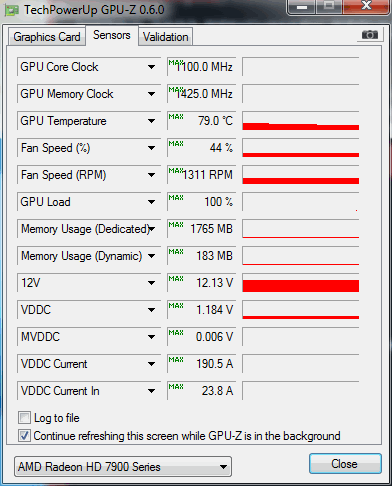
After our additional overclock to 1175MHz, temperatures rose by 5-6°C, but the fans were still quiet. 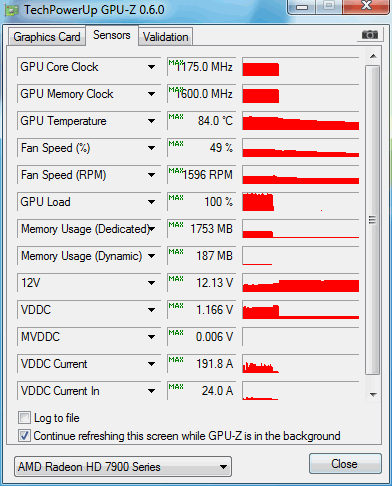
As you can see on the pictures below, Vortex II enables the fans to be elevated by 1cm compared to its initial position. You can incline them or leave them perpendicular, so there’s room to find optimum settings in your case. We tested the HD 7970 Vortex II in Corsair’s Cosmos II case that boasts excellent airflow, so inclining or elevating the fans didn’t do much to provide better cooling. Namely, we measured a single °C of difference. 
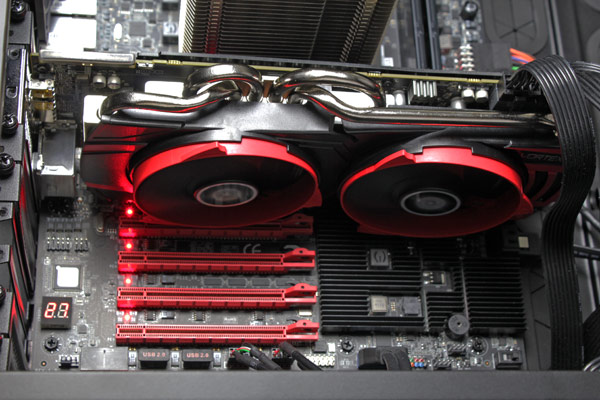

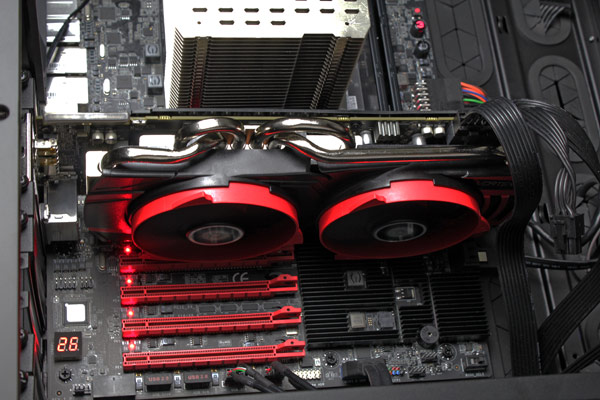
Reference HD 7970 cards come with one 6-pin and one 8-pin power connector which is enough to secure 300W for the card. In extreme situations and at reference clocks, HD 7970 can draw up to 270W. This prompted PowerColor to play it safe and throw in two 8/pin connectors on its HD 7970 Vortex II, which means that the card has up to 375W at its disposal.

In 3D mode, HD 7970 Vortex II draws up to 1.18V, which is close to what the reference HD 7970 requires. 
PowerColor PCS+ HD 7970 Vortex II consumes more than the reference design, but it’s to be expected considering the high clocks. 
PowerColor Radeon HD 7970 PCS+ Vortex II is an example of what kind of performance can be squeezed out of Tahiti XT graphics processors. PowerColor upped the core clocks by 175MHz so the card runs at 1100MHz, which in turn ensured up to 13 percent better performance. Whether it is faster than Nvidia’s GTX 680 depends on the game you’re playing. Namely, sometimes it will be slower and sometimes faster but all in all it won’t have trouble locking horns with GTX 680 cards.
Vortex II cooler will make sure that the GPU isn’t overheating, because operation and long life at such high clocks require quality cooling. In this case, you need not lose sleep as Vortex II will cool the GPU well and still keep noise levels down to an enviable level. In fact, Vortex II cooler is among the quietest we’ve seen on high end graphics cards. We were impressed to see that our additional overclocking to 1175MHz still produced acceptable temperatures and quiet operation.
The only thing that may prevent you from buying this card is that it will not be available in stores for some time. We’ve seen it listed in several stores but there were no exact availability dates. The price starts at about €470, which is €50 higher than PowerColor’s reference HD 7970. The US market should get the card priced some $20 higher than the reference version. In conclusion the card is blazing fast and packs special cooling that will ensure great cooling and low noise levels, which means that the card will definitely be a worthy addition to any gamer’s rig as soon as it’s available.


